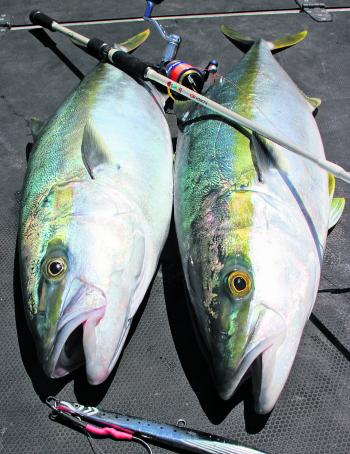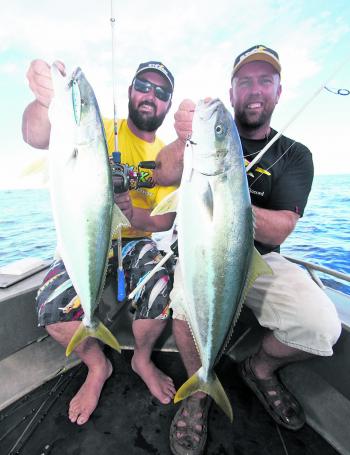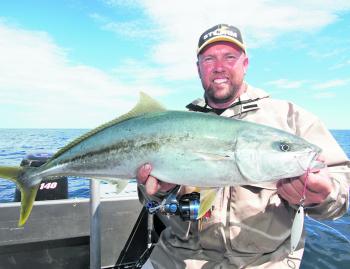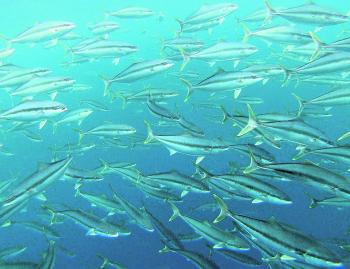Jigging is a popular technique for targeting a wide variety of fish, from snapper to kingfish. One of the reasons that micro-jigging techniques have found a new niche with lure enthusiasts is it is essentially a scaled down version of more conventional jigging techniques and tackle.
But just because it’s scaled down, it doesn’t mean that this tackle can’t pack a punch. You can comfortably use these much lighter durable blanks (fitted with smaller micro guide rods), smaller jigs and threadline reels that can be used all day long without exhausting the angler.
Fishing tackle continues to develop at a fast rate, with new gear coming out each year and if you would have said to me a few years ago that I’d be targeting yellowtail kingfish with micro jigs then, I probably would have laughed, but now I find myself a convert to micro-jigging after landing some great specimens to over 10kg last season.
Summer is here and the warmest months of the year are a great time to get out and chase yellowtail kingfish. It seems that over the past few seasons this species has become more prevalent. Whether this is because more anglers are targeting kingfish or that they are becoming more abundant with the increased water temperatures over the past decade, the mystery remains, but nobody is complaining!
One of the great things about kingfish is that they are an inquisitive schooling pelagic fish and love movement, which makes jigging one of the best techniques for targeting them. When I first started using micro-jigging gear for kingfish, I wasn’t sure how it was going to work out, but now I see that there are plenty of benefits using these techniques and as they say, a little bit of finesse goes a long way in fishing!
There’s a huge range of micro-jigging tackle on the market and I’ve been using the Storm Gomoku range of rods over the past 18 months. They are colour coded with white blanks and micro guides and these are designed for a range of situations and species.
The Keiryo (green) is rated PE-0.4-1.0, the Erito (red) at 0.8-1.5, the Kaiten (blue) at 1.0-3.0 and the Kodachi (black) is rated at PE 2.0-4.0, and is the heaviest model. Braid PE ratings can mean a whole lot of different things these days, so basically, multiply these ratings by 10 and this gives you the range of breaking strain of braids that work well on the rods.
I use the Keiryo for anything from freshwater to light saltwater, from bass to snapper; the Erito for snapper and salmon; and the more serious models for kingfish and tuna, with the Kodachi. The Kodachi PE 2-4 is the pick of rods I use for targeting kingfish. When matched to a 3500-4000 sized threadline reel spooled with 40lb Sufix 832 neon braid, this outfit packs a serious punch. Overhead configurations are also available, but I prefer the threadline models for the simple fact that if need I can quickly cast the jig out if I need to get closer to the fish.
Gomoku micro-jigging rods were originally designed for slow pitch jigging, which essentially means using ‘leaf shaped’ flutter style jigs that have plenty of action by themselves when they fall through the water column. The tips of these rods are very flexible and help to impart action to the jig with a minimal amount of effort so that you don’t have to use the rod aggressively to provide action.
While my preferred Kodachi PE 2-4 model for kingfish is designed to use jigs over 200g, I rarely use jigs over 80g for kingfish, particularly in shallower water up to 50m in depth and in the absence of current. You don’t need to use a big jig to catch a big fish and the more finesse you have, the easier it is to fish with without getting exhausted and losing interest.
Why work a 150g jig all day when you can work one half the size and still get plenty of bites? With these leaf style jigs you will find most of your hook ups occur on the fall of the jig (usually around 90%) so when letting your jig fall make sure you follow it down by dropping your rod. While this style of jigging is not labour intensive, if the fish are deep or you are fishing in current, or both, a knife style jig might be a better selection to get down to the fish.
Knife style jigs are narrow and usually heavily weighted at one end of the jig, which means they will dive quickly to hit their target, however, by themselves these jigs have very little action, which means the angler needs to work the rod and reel to get the action going. As a result this is usually more labour intensive and most of the hook ups will occur on the retrieve.
I always keep a selection of different styles of jigs handy depending on the situation.
Kingfish don’t have sharp teeth or rough bodies, however they can grow to over 20kg in Australian waters and they love heavy structure, so once hooked into a good fish you need to ensure that your connections are sound and you can confidently settle in for a serious battle.
When using micro-jigging rods you need a neat knot that will slide effortlessly through the micro guides, and the best and strongest knot for the job is the FG knot. This is a slim profile knot with almost 100% knot strength. It takes a little longer to tie than an albright or uni knot, but once mastered has many applications. The reason this knot is so slim is that the monofilament or leader material is not actually knotted at all, and it gets its strength from the braided line gripping the leader.
If you are fishing for ‘rat’ kings (2-6kg) you can comfortably get away with 30-40lb leader, but if you know there are bigger fish around or are fishing on heavy structure, I prefer to use 50-60lb leader.
Fluorocarbon leader is a good choice if fishing around heavy structure with its abrasion resistance, but it is more expensive and doesn’t have the stretch of regular monofilament, so generally I use a standard monofilament leader of around 4m in length. That way it ensures that my leader knot is on the reel by the time the fish is ready to be landed next to the boat.
One thing I’ve learnt about kingfish over the years is that the harder you pull on them, the harder they will pull back. When you are vertically jigging and you hook a fish, its natural instinct is to pull directly away from you in the opposite direction. This usually doesn’t work out well if you are a little under gunned, so if I’m having trouble losing line I use my boat to my advantage.
I always like to keep the boat moving and try to lead the fish either away from structure or get it to follow the boat. If it’s following you its most likely not burying its head into the bottom and there is less chance of getting busted off!
The other important thing to remember is to not lock up on a good fish. Some situations will definitely call for lock up and hold on approach, particularly for big fish, but for most of the fishing I do just a steady amount of drag pressure of usually no more than 5kg is plenty for landing a solid fish. This way there is less likelihood of getting reefed and there is usually less chance of a knot breaking or hook pulling out.
It’s not expensive to get into micro-jigging and most rods retail for around the $130-150 range and the jigs are around the $10-15 mark, which means you can often just pick one up and match it to a threadline you have already lying around.
Micro-jigging is effective, affordable and definitely worth trying. And it’s not just kingfish; you can enjoy getting bent on a host of different species using the techniques I outlined in this article. There’s nothing stopping you. Get out there and have some fun!
Reads: 14586
When it all comes together you can land very respectable kingfish on light micro-jigging tackle.

Knife style jigs are usually narrow and heavily weighted at one end like this 150g Williamson Abyss jig. Knife jigs are great to get down deep quickly in fast current to find the fish.

The black gripped Storm Gomoku Kodachi PE 2-4 is my favourite micro-jigging rod and when combined with a 3500-4000 sized reel spooled with 40lb braid, it can really pack a punch! Overhead and threadline micro-jigging rods are also available depending on y

Micro-jigging is great fun with your mates when you hit a school of rat kings and everybody gets hooked up!

Light micro-jigging tackle also gives you the opportunity to get the most out of the rat-sized kingfish. Note the ‘leaf style’ 60g Storm Koika jig used to hook this fish.

Kingfish are a pelagic schooling fish, which makes them a great candidate for targeting with micro-jigging techniques!

To get the most out of vertical jigging you need to use your sounder. This saves time and makes you more efficient. Spend time to find the fish first before dropping the jig! Here is a screenshot from the Garmin 7412xsv of a big school of kingfish sitting

Learn to tie the neat and strong FG knot; it is perfect for many applications!




